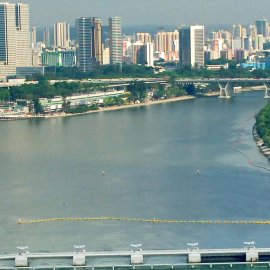Watermark (Pt. 2)
-
English
-
ListenPause
If we truly understand how to value the water cycle and how it works in a time of climate change and unrestricted use, we will inevitably need to define new premises and strategies for management. The United Nations (UNEP) 2011 Report on water measure in a green economy foresees an integrated approach that asks all consumers in whatever form of organization, category of use, or volumetric need to accept a “water mark,” an accepted design for balanced consumption that reconciles demand with availability while administering and distributing the resource equitably and sustainably. The UNEP Report recommends ways forward that require new tools for measurement and management, such as water registers to document actual conditions within a place and understand how allocation can work fairly and adequately in a time of scarcity. Water accounting will be required by which managers can prioritize register information. Existing management structure, typically discontinuous and localized, may need integration and re-organization. Scarcity indicators will need to be established to forewarn managers for planning and future delivery. Demand must be analyzed by sectors and cycles, understanding who needs more water when, seasonally for example. Beyond agriculture, every industry from manufacturing to commerce to tourism will expect stable and consistent supply that in times of extreme and changing weather -- storms, floods, and droughts – must be implemented by policy, planning, and engineering adequate to the condition. A system for regulation, conflict resolution, and pollution control must be defined, affirmed, and enforced. Environment impacts of commercial water extraction and trade must be considered in the context of local requirement, appropriate compensation, and effective sustainability practice to protect the resource from unlimited demand and exhaustion. Such management cannot be seen as a tyranny, but rather as a means to add value to every aspect of the water cycle by home-owner conservation patterns; by fair rates and new management efficiencies; by corporate analysis of cost effective change to reduce operational use and control polluting water waste; by value criteria that enhance investors’ estimate of company value, translating physical economy into reputational value; and by creating resultant water plans that pertain to product manufacture, by import and export of heavily water-dependent trade goods, by revised standards for maintenance of water distribution and treatment systems, and by policy at the local, regional, national, and international level that, according to the Report, involves input from interests representing “environment, agriculture, industry/economic policy, energy, trade, foreign policy and development cooperation.” ...
The global water crisis and the prospects for future water resources is forcing adjustments for how we measure the water that is used, how it is valued, and how (and to whom) it is allocated. In this second episode of a multi-part series on water, host Peter Neill will suggest that in order to understand how to value the water cycle and how it works in a time of climate change and unrestricted use, we will need to define new strategies for measurement and management.
About World Ocean Radio:
Peter Neill, Director of the World Ocean Observatory and host of World Ocean Radio, provides coverage of a broad spectrum of ocean issues from science and education to advocacy and exemplary projects. World Ocean Radio, a project of the World Ocean Observatory, is a weekly series of five-minute audio essays available for syndicated use at no cost by college and community radio stations worldwide. A selection of episodes is now available in Portuguese, Spanish, French, Swahili, and Mandarin, enabling us to reach 75% of the world's population. For more information, visit WorldOceanObservatory.org/world-ocean-radio-global.
Resource from this Episode:
< Measuring Water Use in a Green Economy, UNEP 2012. Lead author: Jacqueline McGlade [PDF]
Pictured: Singapore, challenged by the consumption requirements of its 4.4 million inhabitants, has reached a level of success due to a public utilities board which manages its entire water cycle.
More episodes in the Watermark series:
< Watermark, Pt. 1
< Watermark, Pt. 3
< Watermark, Pt. 4
< Watermark, Pt. 5
- Login to post comments



